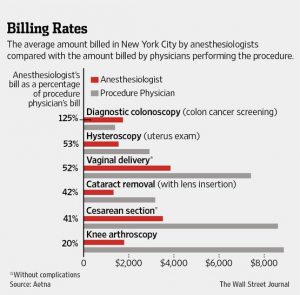Courtesy of The Wall Street Journal (9/27)
Perhaps a lot that could be said here regarding machines over men. The bottom line is that – the bottom line – cost savings without compromising patient safety or quality. Improved care at a lower cost. That remains the fight song for medicine. Of course, improving care at a lower cost, particularly if the lower cost comes at the expense of an expensive practitioner then we may not say we are really trying to improve care at a lower cost – just perhaps improve care without a reduction in reimbursement (i.e. cost) to provide that care. Anyways, physician extenders – be they allied health, nurses, physician assistants, certified providers of subspecialty care, pathologist assistants or “doctors of anatomic pathology”, as I recently saw, and even robots will continue to dot the healthcare landscape.
J&J’s New Sedation Machine Promises Cheaper Colonoscopies; Doctors Fight Back
Anesthesiologists, who are among the highest-paid physicians, have long fought people in health care who target their specialty to curb costs. Now the doctors are confronting a different kind of foe: machines.
A new system called Sedasys, made by Johnson & Johnson, would automate the sedation of many patients undergoing colon-cancer screenings called colonoscopies. That could take anesthesiologists out of the room, eliminating a big source of income for the doctors.
More than $1 billion is spent each year sedating patients undergoing otherwise painful colonoscopies, according to a RAND Corp. study that J&J sponsored.
J&J hopes the potential savings from using Sedasys will appeal to hospitals and clinics and drive machine sales, which are set to begin early next year. Sedasys “is a great way to improve care and reduce costs,” J&J CEO Alex Gorsky said in an interview.


































